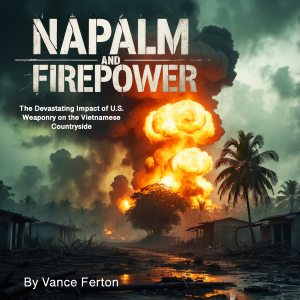

Napalm and Firepower
Vance Ferton
This audiobook is narrated by a digital voice.
The development of napalm as a weapon of warfare represented a convergence of scientific innovation and military necessity that would transform the nature of combat while creating one of the most controversial and devastating tools ever employed in modern conflict. The jellied gasoline that became synonymous with the horror of the Vietnam War originated in the laboratories of Harvard University during World War II, where chemists working under the pressure of global conflict sought to create an incendiary weapon that could burn longer and stick more tenaciously to targets than conventional gasoline bombs. The chemical compound that emerged from this research, named napalm from its key ingredients naphthenic acid and palmitic acid, would evolve into a weapon that could create temperatures exceeding 1,800 degrees Fahrenheit while clinging to surfaces and burning for up to ten minutes.
The chemistry of napalm's effectiveness as a weapon lay in its unique physical properties that combined the destructive power of fire with the persistence of an adhesive gel that could not be easily extinguished or removed from surfaces where it landed. The aluminum naphthenate and aluminum palmitate that gave napalm its gel-like consistency allowed the burning fuel to stick to buildings, vegetation, and human skin while also enabling it to spread into areas that conventional explosives could not reach. The addition of white phosphorus to some napalm formulations created super napalm, which could achieve even higher temperatures while also producing toxic smoke that created additional casualties among those who survived the initial fire damage.
Duration - 58m.
Author - Vance Ferton.
Narrator - Digital Voice Morgan G.
Published Date - Friday, 24 January 2025.
Copyright - © 2025 Vance Ferton ©.
Location:
United States
Description:
This audiobook is narrated by a digital voice. The development of napalm as a weapon of warfare represented a convergence of scientific innovation and military necessity that would transform the nature of combat while creating one of the most controversial and devastating tools ever employed in modern conflict. The jellied gasoline that became synonymous with the horror of the Vietnam War originated in the laboratories of Harvard University during World War II, where chemists working under the pressure of global conflict sought to create an incendiary weapon that could burn longer and stick more tenaciously to targets than conventional gasoline bombs. The chemical compound that emerged from this research, named napalm from its key ingredients naphthenic acid and palmitic acid, would evolve into a weapon that could create temperatures exceeding 1,800 degrees Fahrenheit while clinging to surfaces and burning for up to ten minutes. The chemistry of napalm's effectiveness as a weapon lay in its unique physical properties that combined the destructive power of fire with the persistence of an adhesive gel that could not be easily extinguished or removed from surfaces where it landed. The aluminum naphthenate and aluminum palmitate that gave napalm its gel-like consistency allowed the burning fuel to stick to buildings, vegetation, and human skin while also enabling it to spread into areas that conventional explosives could not reach. The addition of white phosphorus to some napalm formulations created super napalm, which could achieve even higher temperatures while also producing toxic smoke that created additional casualties among those who survived the initial fire damage. Duration - 58m. Author - Vance Ferton. Narrator - Digital Voice Morgan G. Published Date - Friday, 24 January 2025. Copyright - © 2025 Vance Ferton ©.
Language:
English
Chapter 1: The Science of Destruction
Duration:00:11:08
Chapter 2: Arsenal of the Air
Duration:00:11:57
Chapter 3: The Human Cost of Fire
Duration:00:11:11
Chapter 4: Environmental Warfare
Duration:00:11:50
Chapter 5: The Moral Reckoning
Duration:00:12:09